Faculty Lecturers 2009-2019
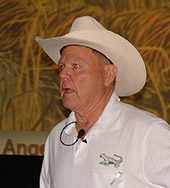
Dr. Bob Gray grew up in an orphanage in Altadena, California. At 17, he started college at Los Angeles Valley Community College. His original career goal was to be an athletic coach. Bob went out for the LA Valley track team. Bob’s track coach explained that his Physical Geology class needed students, so he signed the team up for his class. That’s how Bob Gray discovered his life’s calling.
At 18, he left Los Angeles and went to Idaho to work and decided to go to college at the University of Idaho. He earned two Bachelor of Science degrees: one in Geological Engineering and one in Naval Science.
Upon graduation, the U.S. Navy got him. He served 3 years on active duty (and another 18 years in the Naval Reserves in Naval Oceanography and Intelligence). Bob then returned to college – this time at the University of Arizona – and earned an M.S. in Geology. His Master’s thesis was mapping rock units on the edge of the Grand Canyon. He then went to work for the U.S. Geological Survey in Flagstaff, Arizona and later for a mining company in the Four Corners area, exploring for copper mineral deposits.
After earning his Ph.D. in Geology, he worked in petroleum exploration as a Research Geologist out of Denver. He loved his job, and fieldwork was his passion. He scoured the Four Corners mapping algal carbonate rocks. He mapped from Sedona, Arizona to Rock Springs, Wyoming, and from Denver, Colorado, to Ely and Elko, Nevada. He authored papers on carbonate rocks of the Four Corners region, and on paleontology and sedimentation of non-marine sediments in southern Arizona.
In 1967, Bob switched career paths and came to Santa Barbara City College as an interim geology instructor, a stepping-stone to a four-year university position. Instead, he discovered the joy of “hands-on” teaching at the community college level. He loved working with college students, showing them the wonders of geology.
Almost immediately, he got in on the bottom floor of program-building here at SBCC. He helped create the Marine Technology Program; build the new Life Science-Geology Building (now Earth and Biological Sciences); establish the Geology Majors Program and a two-year Geoscience Technology Program.
Through his contributions, the SBCC Earth and Planetary Sciences Department has developed into a geology program that is second-to-none in the California Community College system. His hard work, field excursions, and the scientific grants that he has written and won over the years have helped to build up the department’s collections of rocks, minerals, fossils, maps and geology field equipment that rival the collections of many four-year geology departments.
Bob Gray is also the “go to” Paleontology Consultant for the Tri-Counties region for the past 25 years. He has authored Paleontological EIRs for numerous California projects.
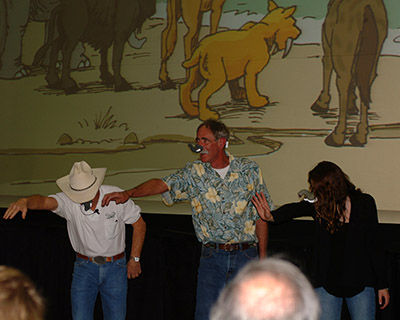
Bob has received numerous awards over the years. Most notable was the Grover E. Murray Memorial Distinguished Educator Award from the American Association of Petroleum Geologists at their international annual meeting in 2008. This award is given to only one college geology educator in all of the United States per year. Bob is the only community college educator to receive this award since its inception.
Some of his other notable awards include the “Thomas Dibblee Distinguished Lecturer Award” from the Santa Barbara Gem and Mineral Society in 2006, the “SBCC Faculty Excellence Award” in 2003, the “John Woolley Outstanding Undergraduate College Educator Award” from the Coast Geological Society in 2003, the Pacific Section American Association of Geologists “Distinguished Educator Award” in 1998, and SBCC’s Cal Reynolds’s Award for his outstanding service to SBCC in promoting student activities in 1981 and 1982.
In 2006, Bob was honored by the Dibblee Geology Center at the Santa Barbara Museum of Natural History when they published a geologic map in his name. On certain appropriate occasions, the Dibblee Center releases a new published geologic map to honor an outstanding geologic professional whose “work has been of significant value in promoting field geology.” The Geologic Map of the Big Pine Mountain Quadrangle, Santa Barbara County, California is dedicated to him.
Bob is a tireless volunteer in our community. He leads/assists the YMCA
Fit for Life Senior Fitness class two to three times a week. He represents SBCC at
almost every local elementary school science fair. He gives talks to various geological
organizations, scientific societies and community groups whenever asked. For over
16 years he coordinated the Santa Barbara City College Geology Club’s “Mucker’s Ball”
– a 49ers style – event in which the SBCC Campus Center was transformed into the 1849
Mother Lode and Gambling Casino.
Outside his professional life, Bob met his wife, Marcia, at a country-western dance
class in 1990. Marcia propelled Bob into the world of country-western dance competition
(think “Dancing with the Stars”). By 1996, they had competed their way to the top,
and they became the World Champions in the Showcase Gold Division at the Country-Western
Dance Competition
in Nashville, Tennessee.
Bob follows a path of dedication, excellence, enthusiasm and unstinting generosity. To his core, Bob believes that the beauty of SBCC’s geology program is not the new building, the scientific equipment, the extensive rock and paleontological collections, or even the nonpareil field geology program – it is the geology majors. Bob has an infectious love for geology and a passion to teach by caring. But in caring, he would tell you that he demands excellence and is relentless in dogging his students to do better and to excel to their utmost. Bob knows that true teaching must be concerned with the whole student, whose attitude, orientation and performance is formed by a multitude of experiences.
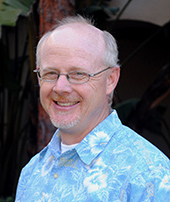
Dr. Michael Young grew up in the East Los Angeles county area and is a proud product
of the California educational system. His first step into physics can be traced to
his middle school teachers. Somehow, they saw a talent he didn’t. While he was busy
riding bicycles, assembling and disassembling “stuff,” and lighting the canyons of
Los Angeles on fire (don’t ask), they recommended he be placed in a college preparation
physical science class his freshman year of high school. After his first
day at high school, and not being in the same class as his friends, he asked to be
transferred from this class to one with all his friends. Luckily for him, the counselors
were overworked and could not see him for five weeks. By then, he found that not only
was he getting an A, but he loved science because it explained how things worked and
was intellectually challenging.
That freshman year, he had two outstanding teachers - one in math and the other in science. Four years later, he had many other outstanding teachers. One teacher, Mr. Edmonson, was his physics and math teacher. Mr. Edmonson not only made math and science fun and active, but correlated it to the real world. After all, Mr. Edmonson had worked on the Manhattan Project. Dr. Young was amazed at how physics applied a few powerful, fundamental concepts to explain a universe of physical phenomena. He entered college, at Point Loma Nazarene University in San Diego California, as a physics, engineering, math, or chemistry major, but quickly ruled the others out, as physics seemed, in his view, far more amazing, engaging, and intellectually challenging.
At college too, he had an astounding set of teachers who made science practical, interesting, challenging, and lively. After finishing his bachelor’s degree in San Diego, he moved back to the Los Angeles area to attend UCLA where again he was fortunate enough to have some more incredible teachers (Can you believe their names were Bert and Ernie?). At UCLA, he completed his M.S. and Ph.D. in physics. Enjoying the applied side of physics, his Ph.D. was a cross discipline study in the field of photonics, or lasers, with both the school of science and the school of engineering.
Dr. Young believes his background gives him a unique perspective for teaching physics at the community college level. First, as were examples to him, he believes physics should be dynamic, entertaining, and practical. Lectures should be delivered with an infectious passion and challenge. Second, his cross discipline studies in both schools of physics and engineering give him the expertise to teach and reach the two major groups in his calculus-based physics classes - the science majors and the engineering majors. And third, attending public schools and growing up in LA County, he has real world dealings and understandings of diverse population groups.
Dr. Young has extensive roots in community activities. He shares his expertise and excitement of physics with elementary school students and their teachers, called “Physics Phun Phridays.” Today’s lecture on molecular motion developed from these visits to kindergarten through sixth grade classes. He also serves on the community advisory budget committee for his local K-12 school district, Ventura Unified. He spends a significant amount of his time and work committed to youth sports programs. He currently serves on the Board of Directors for the Ventura County Track Club Tigres. Also, over the past nine years, he has personally coached 19 youth sports teams from baseball, soccer, track, and basketball. Many of you here today will remember his time raising money for PONY, Protect Our Nations Youth, baseball.
Dr. Young has also taught Sunday School and guided middle school activity nights. Another middle school program was his work with Light-Speed, a two-day NASA sponsored program designed to expose middle school students to science and technology.
At SBCC, he has served on the Academic Senate and numerous faculty committees such as the ITC and the Compressed Calendar Committee. He has served as Department Chair for over 10 years and chaired ITC. In his early years at SBCC, he was the Faculty Advisor for the Natural Philosophers Club and the Gaming Club.
Surprisingly, Dr. Young never planned a career in teaching. His career goals were always research and development of photonic systems. His first step toward a teaching career started his second year of college. He was“drafted” by the math faculty to teach/tutor for their self-paced, independent study math program. Following that, he was “drafted” by the physics faculty to teach physics labs. Within his first year of graduate school at UCLA, he was promoted to Head Teaching Assistant and directed their program to train incoming teaching assistants. In his second year, he won the “Most Outstanding Teaching Assistant” award. Yet, in spite of all these enjoyable jobs and positive feedback in the area of teaching, his career plans did not change. Late in his graduate school career and at the insistence of some math faculty, he taught his first community college mathematics class. These soon grew into teaching of both math and physics followed by additional teaching jobs at other community colleges. He soon won the “Outstanding Adjunct Teaching Award.” At this point, he decided to continue to teach at the community college level until he was no longer having fun. Twenty years later, he is still saying the same thing, but now doubts if he will ever stop having fun.
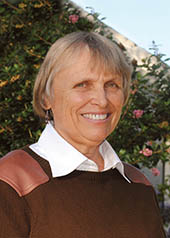
Kathleen (Kathy) O’Connor was born in Los Angeles but has been a resident of Santa Barbara since she was an infant. After graduation from Carpinteria High School, she earned an A.A. Degree from Santa Barbara City College, a B.S. in Physical Education from the University of California, Santa Barbara, and an M.A. in Physical Education from Cal Poly, San Luis Obispo.
During two years at Laguna Blanca School, she developed the girls’ PE and athletics
program while teaching physical education and coaching teams in four sports. This
was followed by a year at Goleta Valley Junior High teaching science and physical
education after which Kathy was a part-time instructor in physical education at SBCC
for two years. During that time, she started the college’s athletics program
for women before being hired full-time in 1976.
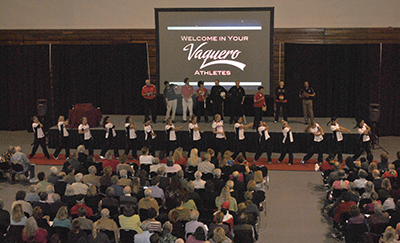
Kathy’s years at SBCC have been characterized by her involvement in college governance. This has included 20 years on the Academic Senate, with two years as its president, and service on numerous Academic Senate committees, including Curriculum Advisory, Instructional Technology, Scholastic Standards, and Planning & Resources. She continues to serve on college-wide committees, including College Planning Council, District Technology Committee and Matriculation. She was also among the first faculty members to develop distance-learning classes at SBCC, and she has been an Athletics academic adviser for over 30 years.
Her involvement has extended to the state level where, as a representative of the Academic Senate for California Community Colleges, she has made numerous presentations at plenary sessions and co-authored two ASCCC publications. As a representative of the State Academic Senate, she was appointed to—and served as chairperson of—the Distance Education Technical Advisory Committee and, more recently, was appointed to the System Office Advisory Committee on Curriculum and the Kinesiology Discipline Committee to develop transfer degrees.
Kathy has received several awards for teaching and professional excellence: the SBCC Faculty Excellence Award, the Academic Senate for California Community Colleges’ Hayward Award for Excellence in Education, the Community College Foundation Award for Outstanding Achievement in Technology Education, and the Louise Lowry Davis Sportswoman of the Year Award presented by the Santa Barbara Athletic Round Table.
The local community has also been the recipient of her dedication. As a horse owner, she recognized the threat to horses posed by wildfires, and was co-founder and president of the Santa Barbara Equine Assistance and Evacuation Team. She continues to be actively involved in providing training and educational opportunities for emergency services personnel and community members. Kathy has made presentations to community organizations on such topics as fitness and nutrition, self-defense for women, drug and alcohol education, and women’s health issues.
Kathy sums up her approach to both education and life with the phrase, ”If it’s not broken, break it,” by which she means that it’s often necessary to take apart and examine underlying assumptions, evidence or convictions upon which our decisions or actions are based. “As educators, teachers make a difference when we help students overcome their fear of change and develop the courage to live by a set of values that will reinforce their self-esteem and self-respect. However, we can only assist them in doing this if we are willing to take risks, lead with our hearts, maintain high expectations and, most importantly, teach by example.”
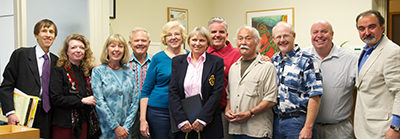
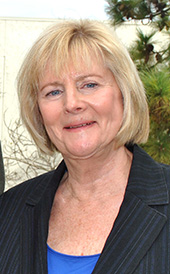
Kathleen (Kathy) Zarwell Molloy was born and raised in Los Angeles. A history major at the University of Southern California, she picked up a degree in English as well. During college, she met her husband, Paul, and married two years later. After spending a year camping through Europe and North Africa, they moved to Santa Barbara, where they both enrolled in graduate school at UCSB. After receiving secondary credentials, she and Paul taught high school at Bishop Garcia Diego High School in Santa Barbara for several years until the birth of their first son. Later they shared a teaching position in the ESL Program at SBCC’s Continuing Education Division. After the birth of their second son, they decided it was time to return to school, and two years later they received their master’s degrees and applied for teaching positions at Santa Barbara City College. A year later, Kathy was hired full time in a position split between the English Department and the English Skills Department, and not too long after, Paul was hired full-time in the ESL Department.
Kathy served as department chair for English Skills and Director of Composition for the English Division. At the same time, she became the English Division representative on the Academic Senate, serving for 16 years as a senator, member of the Steering Committee and eventually as the Senate President. During her tenure as Academic Senate President, she led the Senate’s Student Success Initiative. The result of the Senate’s work was the Partnership for Student Success, SBCC’s award winning collaboration of tutoring programs. She continues to serve as chair of the Partnership’s Steering Committee. In 2010, when SBCC received its first Title V Hispanic Serving Institutions grant, she was asked to become the Project Director. Since then, she has worked with faculty from English, English Skills, Math and Counseling to plan and implement the Express to Success Program (ESP). Begun in Fall 2011, ESP offers accelerated learning communities for students in developmental math and English and recently received the Chancellor’s Award for Best Practices in Student Equity.
In 2009, when the Statewide Academic Senate appointed Kathy as the Faculty Professional Development Coordinator for the Basic Skills Initiative, she led a team of community college faculty, including SBCC’s Dr. Jerry Pike, in planning and staging eight regional workshops that showcased some of the effective programs and practices in California community colleges. She has continued to work on the state’s Basic Skills Initiative, currently serving on the Chancellor’s Basic Skills Advisory Committee and recently leading the Senate’s efforts to create a Basic Skills Initiative E-Resource,
a review of projects and successful programs that will be released Spring 2013.
During her career at SBCC, Kathy has been recognized for her teaching and support of our EOPS and DSPS students, and she has received the Faculty Excellence Award from her colleagues. In 2011, she was selected as recipient of the Stanback-Stroud Diversity Award by the Statewide Academic Senate and the Foundation for California Community Colleges.
Whenever the opportunity presents itself, Kathy loves to travel. She and her sons, Kevin and Matt, have traveled in over 60 countries, and when she isn’t travelling, she is planning her next trip.
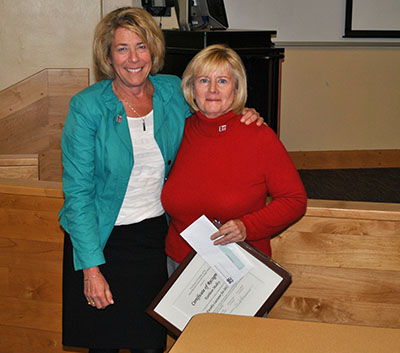
Blakely (Blake) Barron was raised, along with his taller “little” brother Matt, by his loving and devoted parents, Paul and Neva Barron in Ventura County. It was from watching his parents work so hard that Blake learned his work ethic. While he was born in Fort Sill, Oklahoma (in an army hospital as his father was returning from Vietnam) he grew up entirely in Southern California. Fond thoughts of explorations and an innate curiosity for the outdoors dominate Blake’s childhood memories. Hiking, camping, swimming and reading were and still are among his favorite activities. He has always been a voracious reader and not surprisingly was drawn into the worlds of science fiction, fantasy and Dungeons and Dragons. As a self-described science geek, he was excited when his parents got him one of the earliest home computers, a TI-99/4A, with a whopping 16KB of memory! A fascination with technology, data collection and analysis was born.
He is a proud graduate of the public education system in California, which he attended from elementary school to the University of California, Santa Barbara. Some of his abilities as an instructor today come from this early exposure to innovative teaching by committed science teachers. He has always been attracted by the sea and after graduating from Moorpark High School in 1986 he washed up on the beaches near UC Santa Barbara. Blake earned a Bachelor of Arts in Physiology and Cell Biology from UCSB in 1991.
In graduate school at UCSB, Blake’s research was focused on various aspects of reproductive physiology in fish. Blake accepted the opportunity to not only be a Teaching Assistant for three different biology courses at UCSB but also to lecture one semester for an upper division vertebrate reproduction course. These rich experiences kindled a fiery interest in teaching. Blake earned his Master of Arts in Biological Science with an emphasis in Comparative Physiology in 1996 and he knew that, while research was indeed fascinating, a career focused on teaching was his desired goal. Blake reflects on this period as one of the luckiest times in his life. As one of his last T.A. positions at UCSB was ending, Blake was exceedingly fortunate to be hired as an adjunct faculty member by the Department of Biological Sciences at Santa Barbara City College in 1996. Between 1998 and 1999, Blake married his lovely wife Janet, purchased his first new car and was hired as a full-time, tenure-track professor at SBCC.
The past 17 years at SBCC have been tremendously fulfilling for Blake. There is a true sense of community at SBCC. With wonderful mentors in his department and around campus, Blake has learned to be the best teacher he can while simultaneously experiencing great personal growth. Much of his professional development comes from the opportunities Blake had teaching a range of 14 different majors and non-majors courses in the Biological Sciences Department. This diversity has provided Blake with a breadth of knowledge that he can continually integrate and share with students.
Blake enjoys being involved in multiple aspects of our campus culture. After briefly serving on the Honors Advisory and Student Services Committees, Blake jumped in the deep end of the committee assignment pool. He had the privilege of doing the important and sometimes difficult work performed by the Faculty Academic Senate from 2004 to 2007. Blake has been both Biomedical Sciences Coordinator and Biology 100 Coordinator and is member of the One Planet faculty. He currently serves as Department Chair for Biological Sciences and has previously served as co-chair. The STEM (Science, Technology, Engineering and Mathematics) Transfer Program Faculty Workgroup is one of his favorite current committees as they develop strategies and pedagogy to facilitate student success in STEM courses. In 2011-12 Blake was honored to earn a SBCC Faculty Excellence Award.
Santa Barbara City College is #1 in the nation (2013, The Aspen Institute Prize for Community College Excellence) because our students are the focus. Blake was very proud to serve as the lead coordinator to write and guide the A.A. in Liberal Arts: Biomedical Sciences Emphasis degree through the campus- and state approval processes. Blake is most proud to be the Faculty Advisor for the Biology Club since Fall 2008. The level of dedication to service and exploration exemplified by the devoted student members of the SBCC Biology Club is impressive.
Blake’s teaching philosophy is characterized by high expectations for both himself and his students tempered with compassionate consideration of the diversity of our students and recognition of both their fears and potential. As primates, humans are social critters. Our survival and ability to thrive is predicated on our establishing effective relationships and staying connected. Blake looks forward to many more years of adventure, discovery and fun at SBCC!
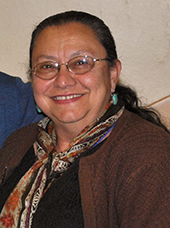
Sonia María Zúñiga-Lomelí was born in the seaport city of La Ceiba, Honduras. In 1967, when she was 15 years old, she migrated to the United States and settled in Brooklyn, N.Y., where she attended Prospect Heights, an all-girls high school. She attended Queens College of the City University of New York and received a B.A. in Applied Linguistics (1976). She went to the University of New Mexico (UNM) and started her M.A. work in Spanish Linguistics, but changed to Hispanic Literature when she took a Spanish literature class, taught by the great Chicano writer Dr. Sabine Ulibarrí. At UNM, she met her husband, Francisco A. Lomelí, while he completed his doctorate in Latin American Literature. In August of 1978, in a span of 3 days, Francisco defended his dissertation; Sonia and Francisco got married, and drove back to California, where Francisco started a joint appointment in the Spanish and Portuguese, and the Chicana/o Studies Departments at UCSB. Sonia and Francisco have three children: Natasha, a 5th grade teacher at Notre Dame Elementary School; Carlos, co-owner of Nite Bite, a late night food delivery service; Yazmín (currently at Humboldt State). All of her children graduated from Notre Dame Elementary School, Santa Barbara High School, and attended Santa Barbara City College.
Sonia’s childhood was spent in La Ceiba, where she was exposed to Spanish, English (Jamaican and U. S.), Garífuna and Latin (the language of prayer and Mass). But since this was a seaport, sailors who spoke a myriad of other languages visited the city. It was this exposure to the many samplings of people’s expressions that made her curious about language. This seaport was also where she learned how important it was for people to have a voice and to be heard.
Sonia’s journey as a teacher started at Queens College where, as an undergraduate student, she worked in a summer program aimed at inspiring and empowering Puerto Rican high school students to continue with their education and to see college as a viable option. This was truly a pivotal experience for her, because in the process of working with these students she discovered and fell in love with the idea of becoming an educator. At UCSB, she studied Spanish, Portuguese and Latin American Literatures, became actively involved in the graduate student group on campus, and was instrumental in the creation of Tinta, a literary magazine by and for graduate students. Under the tutelage of Professor Sara Poot-Herrera, she wrote her dissertation on “¿Quién se tragó la selva? Cuatro novelas ecológicas costarricenses / “Who Swallowed the Jungle? Four Ecological Costa Rican Novels”, and earned her Ph.D. degree in 2003.
Sonia has been a full-time faculty member in the School of Modern Languages (SoML) and an active member of SBCC since 1990. She has led many initiatives and, together with her colleagues, she has worked continuously to make the School of Modern Languages an integral part of our students’ well-rounded and global preparation. A strong supporter of students experiencing language and culture through Study Abroad, she has participated as Director of programs in Costa Rica, Cuba, Mexico, and Spain. She also helped design and implement the first ASL and Japanese intensive summer programs to give students an immersion experience without leaving Santa Barbara.
To meet the needs of students’ different learning styles, she developed self-paced language courses, has also been involved in the development of language placement tests and the testing of language proficiency, and the development and revision of the Spanish for Heritage Speakers curriculum. Most recently, Sonia has worked with the Bilingual GED faculty to develop curriculum for Spanish literacy as a foundation for students learning English as a Second Language.
Sonia has been passionate about recognizing students’ dedication to the demands of learning another language, and to honor and recognize those students who rise to the occasion, she worked to establish a chapter of the Spanish Honor Society Sigma Delta Mu. She also worked to establish the yearly SoML Outstanding Students Awards Ceremony. She has been involved in college governance serving as department Chair, on the Academic Senate and on numerous committees: Curriculum Advisory, Instructional Technology, Planning and Resources, Academic Policies, Program Evaluation, as well as on evaluations and new hire committees. Her peers nominated her twice for the Stanback-Stroud Diversity Award. She has served as an adviser for the Spanish Club, MEChA, and the Esperanto Club.
For Sonia it was—and still is—inspiring to experience humanity as one, with its different shades, sizes, and languages. One life lesson she has learned is that language should not be taken for granted and should be cultivated to achieve productive communication. “Hablando se entiende la gente” is one of her favorite sayings, which means, “By speaking to one another, people reach true understanding."
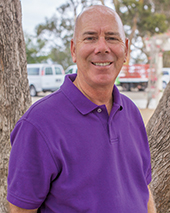

BIOGRAPHY – INTERVIEW
The following interview with Dr. Lake occurred a few weeks ago as he strolled along the Santa Barbara shoreline.
Q: Let’s start out easy. What is your favorite color?
A: Purple. I have been told it is the color of royalty and that I wear the color well. My students get a kick out of seeing my purple “Chucks.”
Q: Let’s get a bit more challenging. Who was your favorite teacher?
A: This is not challenging at all. Like everyone, I have had several great teachers throughout my educational journey. Mrs. Bailey was a teacher I had at South Wayne Elementary School. She was short in stature, but big in how she made learning fun. I remember we took a field trip and it was so neat to be outside of the traditional classroom and still learn. She was patient with me, got to know me, and she saw something in me that made me think I could succeed.
Q: What values do you hold dear?
A: Education and Service to Others. Both of my parents, Christie and Francis Lake, consistently demonstrated these values. Education was seen as an opportunity, a foundation for having a better life. Service to Others was seen as your obligation. Even though you might not have much, there was always someone who had less. It was your obligation to do something to help them have a better life.
Q: How has the value of Education played out in your life?
A: As a child, I attended elementary, junior high, and high school with the idea of getting the most I could out of my experiences. There were some rough spots, but I ended on a high note and was accepted to college. During my journey into the world of higher education as a student, I continued to want to learn more, do better, and see what the big world was all about. My education culminated in my earning a Doctorate of Education. It was the best academic experience I ever had! I was proud of what I had accomplished and the hard work I put in. The support of my husband was unwavering and my friends and colleagues were a great support system. It was worth everything!
Q: How does the value of Education and your personal journey as a student influence your teaching philosophy?
A: With a primary role as an early childhood educator teaching adults students to be teachers of young children, I have a teaching philosophy that features optimal teaching and learning occurring in the context of a relationship, not a vacuum. The environment for effective teaching and learning is a series of on-going student-teacher interactions. With the classroom serving as the environment and the course curriculum as a tool, I guide Early Childhood Education students in understanding the complexities of their behaviors as well as those of young children through a respectful, responsive, and reciprocal process. I facilitate a learning environment where it is safe to ask questions, express differing views, receive constructive feedback, and be passionate advocates for young children. A physically-safe and emotionally-safe atmosphere allows the Early Childhood Education student to be in successful pursuit of her or his educational goals and dreams.
In addition, the teaching and learning process is an integral part of the lives of the students, as their home, social, and college lives are intimately intertwined. Therefore, I practice a philosophy of Early Childhood Education not only to teach students specific information or skills for a career objective, but also to also provide hands-on, meaningful and challenging learning experiences. By including opportunities for dialog and times for reflection, I encourage Early Childhood Education students to become productive leaders in their communities.
Q: Let’s go back to the value of Service to Others.
Talk to me about how that value is present in your life today.
A: In viewing teaching as a way to be in Service to Others, I have served on various campus committees and have been asked to serve in several leadership positions at Santa Barbara City College. In addition, I have been a key contributor to several state-wide early childhood education projects, president of the California Association for the Education of Young Children, and a principal advisory board member for the Children’s Museum of Santa Barbara. As a result of this service work, I have been the fortunate recipient of the Santa Barbara City College Faculty Excellence Award and twice nominated for the California Community College Hayward Award.
Q: After graduate school, what was your first job?
A: I conducted psychiatric evaluations in the emergency room of a community hospital. It was an eye-opening experience. I learned so much about people and most importantly, myself.
Q: Not counting your current position, what has been your favorite job?
A: This is another easy one. Anytime I have been teaching with young children it has always been the best. There is just something for me about being at their level, seeing the world through their eyes, trying to figure out what their brains are thinking and feeling that I find truly extraordinary and fascinating. I figured out that my lap capacity for pre-school children is five. That is important to know when reading a story.
Q: What is something that most people, including your students, might not know about you?
A: One thing might be that I love to swing on swings. I grew up with a swing set in the backyard and I would spend hours swinging and trying to “touch my toes to the sky.” I just love that feeling of movement and freedom. In Santa Barbara, I have been seen on the swings at East Beach enjoying myself. Another thing is I enjoy a good laugh. Once I was laughing so hard I needed a tissue. It was great fun and I think a fun surprise for my students.
Q: What is your favorite word?
A: Enjoy! I have been blessed with an incredible life and do not take it for granted. Even through the tough times, the hard work, the sacrifices I made early on, I have continued to find that place of enjoyment. I want to make sure I do my best every day to enjoy it to the fullest. Also, I want that for everyone. Enjoy!
Q: Congratulations on your selection as the 2015-16 Faculty Lecturer at Santa Barbara City College.
A: Thank you. I am very honored and humbled.
ACKNOWLEDGEMENTS
The honor of being selected Faculty Lecturer means many individuals have participated in the making of this day’s events. Some individuals have had the focus of working with me on only today’s activities while other individuals have had many years in making this day be extra special.
To the many different staff departments and individuals who were patient with me and provided gentle guidance in how things could be done, I thank you for taking my vision and making today a reality.
To the faculty of the Early Childhood Education Department, I thank you for creating a space that encourages me to do what I do in the way that I do it. I appreciate your professionalism in doing what you do best, your dedication to all students enrolled in the Early Childhood Education Department, and your ability to play and laugh as we strive to create a teaching and learning environment based on research principles and best practices.
To the many students who have taken an early childhood education course with me over these many years, I thank you for your interest in young children and making a commitment to ensuring their world is safe—physically and emotionally—as well as filled with positive learning experiences. You have so many talents. Go for It!
To my friends and colleagues in the early childhood education profession, I thank you for your continued support. You have provided me with guidance, inspiration, and laughter. As I have evolved as an educator as well as a contributor to many programs and projects, I am blessed to have accomplished so much with your assistance while helping others create pathways to be who they are and who they want to become. Enjoy!
To the administration and faculty at SBCC, I thank you for being kind people who say “Hello” as our paths cross on campus. I appreciate your commitment to SBCC, our students, and to teaching and learning as truly noble endeavors that are filled with many challenges and many more joys. Knowing you has made me a better teacher and, more importantly, a better person.
DEDICATION
I dedicate the 2015-16 Faculty Lecture to the following:
Robert Welly—my husband, who has helped me create a life filled with laughter, new discoveries, respect, and love—always and forever.
Christie and Francis Lake—my parents, who instilled in me the values of education and service to others along with a selfless work ethic.
Bruce, Jill, Denny, and Beth Lake—my brothers and sisters, who taught me many lessons about getting along with others, using your voice, and always doing your best.
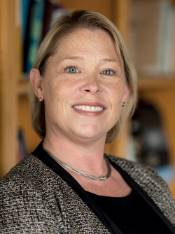
Pam Guenther began life as a Word Bringer
Born in Omaha, Nebraska, Pam is the oldest of four children (and only girl) of Gerald Zimmerman and Kathleen Reilly. Both of her parents were deaf and Pam became their connection to the hearing world at a very young age. She was their interpreter, even answering the phone at the early age of three. As the first child, she helped to teach her younger siblings how to speak and survive in an aloof world. She brought new words into the home like gifts from a secret source.
When Pam was seven, the Zimmermans moved to Ashland, Nebraska, a town with a population around 2,000, nestled between Omaha and Lincoln. Pam credits the teachers and families in the town for allowing them to grow up without a sense of their limitations and teaching them a small town work ethic. In high school, Pam was able to participate in volleyball, basketball, track, speech, debate, swing choir, and theater. She graduated valedictorian of her class and, as an academically talented senior, was invited to the University of Nebraska-Omaha Distinguished Scholarship Competition exam and performed well enough to receive one of the five full scholarships to the university.
In fall of 1989, she began her pursuit of a bachelor’s degree in mathematics at University
of Nebraska-Omaha, with a minor in communications.
To support herself in college, she had to give up her theater hobby, and began working
three jobs. As a member of the Honors Program, her Honors Senior Thesis compared individualized
instruction with lecture-taught mathematics courses. In 1994, she was named the Math
Honor Student by the mathematics department and graduated summa cum laude.
In 1993, her mother died suddenly of an asthma attack at the young age 47. Left bereft and adrift, Pam decided it was time for a change. Coupled with an uncertainty about what she wanted to be when she grew up (though she knew she NEVER wanted to be a teacher), she began to apply at graduate schools in distant and warmer places than Nebraska! She landed at Arizona State University with a fellowship and teaching assistant appointment. She was grateful for the financial assistance to attend school, but petrified of the teaching assignment—until she taught her first Elementary Algebra course. She fell in love with the little light bulbs that went off in the classroom every day. She fell in love with the idea of helping students see the beauty of the subject she loved and she fell in love with converting their anxiety about mathematics to a belief that they could do it. This passion led her to participate in every part of learning the art of teaching mathematics.
Pam was an elected member of the Organization of Graduate Students and helped train all incoming graduate students to be teaching assistants. She completed her Master’s in 1997, was hired as a full-time instructor in the First Year Mathematics department at Arizona State University, and began teaching part-time at Mesa Community College. She worked closely with the Disability Resource Office, presenting workshops on math study skills for students with disabilities and offering a section of mathematics just for students with disabilities during two summer sessions. She was the director of a service learning program that brought pre-service elementary teachers to teach math to second graders at the Salt River Pima-Maricopa Indian Community. She also was the math supervisor for the ASU summer bridge program, a program for “at risk” freshman entering ASU in the fall. In 1998, an interdisciplinary PhD program in the Mathematics Department and the College of Education was created and Pam began coursework toward the Mathematics Education doctorate. She and her colleagues wrote an activity book to supplement Math for Elementary Teacher courses, “Active Math: Activities for Prospective Teachers.”
In the spring of 1999, while attending a national math teachers’ conference in San
Francisco, Pam met a high school teacher from California,
David Guenther. They fell in love and were married, and David lured her to the Golden
State. She began teaching at SBCC in August 2000.
While at SBCC, she has been involved in math education for teachers locally and nationally;
helped create a math course for nursing students and refresher courses for pre-algebra,
elementary algebra, and intermediate algebra; and created supplemental materials to
enhance courses in the culinary arts program. Pam is an original member of the Partnership
for Student Success, a faculty-driven initiative that is the umbrella for student
support programs on campus, such as the Gateway Tutoring Program. She also piloted
an accelerated algebra sequence that helped lay the groundwork for the Title V grant
that created the award-winning Express to Success Program. She is currently working
on the state Basic Skills Transformation
grant and the federal Title III Removing Barriers to STEM Education grant, both of
which are focused on improving access and success for
underrepresented students in mathematics.
Pam has two children in middle school, Madeline (13) and Colin (12), and between their
activities and her husband’s coaching, spends most nights
and weekends grading papers at practices, lessons, games, and performances.
—Hugh Reilly, Pam’s godfather
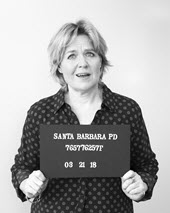
ABOUT THE LECTURER
In January 2018, Professor Anne Redding was interviewed at the Santa Barbara Police
Department regarding allegations that were ballot tampering involved in the selection
process for the 39th Faculty Lecturer at Santa Barbara City College. The following
are excerpts from that interview.
Detective Briscoe: Good afternoon, Professor Redding. Thank you for coming
to the station to talk with us.
Redding: I was told there’d be pizza.
Detective Briscoe: I’m afraid you’ve been misinformed.
Redding: Whatever.
Detective Briscoe: Why don’t we start at the beginning. Could you tell me a little bit about your background?
Redding: My twin brother and I were separated at birth.
He went to live with our uncle and I was adopted by a senator
from Alderaan. I was a bit of a rebel when I was younger. The
first time I met my father was when he busted me for trying
to smuggle some blueprints of the Death Star to some friends
of mine. He boarded my ship –
Detective Briscoe [interrupting]: Professor, you’re describing
the origin story of Princess Leia. I’ve seen the movies.
Redding: Whatever.
Detective Briscoe: Okay, I’ll be more specific. Can you tell me
about your educational background?
Redding: By the time I was ten years old I was living in a
cupboard under the stairs of my aunt’s house. One day an owl
delivered a letter informing me that I had been accepted to
Hogwarts School of Witchcraft and Wizardry. I spent the next
eight years studying there –
Detective Briscoe [interrupting]: Professor, I’ve seen those
movies too.
Redding: Whatever.
Detective Briscoe: We’ve done some checking on you. Our
records show that you were born in Maine and spent your early
years in New England before you moved to California at age
12 with your mother and sister. You attended Burroughs High
School in Burbank. At age 17 you enrolled at Los Angeles Valley
College where you completed your CSU lower division general
education requirements. You then transferred to California
State University, Los Angeles, where you earned your Bachelor’s
degree in Criminal Justice, and then your Master’s degree in
Public Administration. Isn’t that true, Professor?
Redding: Whatever.
Detective Briscoe: Could you tell me about your work history
prior to being hired by Santa Barbara City College?
Redding: I started out at the FBI. While still in the academy, the
Behavioral Science Unit Chief, Jack Crawford, sent me to the
Hospital for the Criminally Insane in Baltimore to interview an
inmate. At first, Dr. Lecter was a real jerk, but later –
Detective Briscoe [interrupting]: Okay, I need to stop you right
there. I can see where this is going, so maybe you can at least
confirm what our detectives have learned about your work history.
You started working very young, delivering papers for The Boston
Globe when you were just twelve years old. Once in California,
there is evidence that suggests that at age 14 you became the
youngest Avon representative in the L.A. area at the time. Records
also show that you worked at McDonald’s and Taco Bell while in
high school, as a security guard at local film studios, and then
a bookseller at Waldenbooks while in college. You were hired by
the city of Los Angeles as a law enforcement park ranger when
you graduated with your Bachelor’s degree, and you then began
teaching part time at Rio Hondo Police Academy in Whittier,
California. Your first full-time teaching job was at Unity College
in Maine where you specialized in conservation law enforcement.
After two years at Unity College you were hired as an assistant
professor by Antelope Valley College in Lancaster, California, where
you later became department chair of their criminal justice program.
Finally, you were hired by Santa Barbara City College in 2004
where you have taught ever since, becoming department chair of
the School of Justice Studies in 2013. Isn’t that correct, professor?
Redding: Whatever.
Detective Briscoe: Perhaps we can shift gears here.
Congratulations on being named the 39th Annual Faculty
Lecturer at Santa Barbara City College. I understand that at
least two people are looking forward to your lecture –
Redding [interrupting]: It’s up to two?!
Detective Briscoe: Yes. Your sister confirmed—after your mom
told her you were paying both of their expenses, plus spending
money—to come see it. Do you feel you need to pay people to
attend your lecture?
Redding: Whatever.
Detective Briscoe: Can you tell me what you have planned for
your lecture? What are you going to talk about?
Redding: Finally, a good question! I’m extremely excited about
this honor. The title of my presentation, Crime Across the
Curriculum, is also descriptive of what I’m going to talk about.
In the process of educating people about what we do in the
School of Justice Studies, I’ll be demonstrating how the issues
surrounding crime and justice are highly interdisciplinary. I’m
hoping to also show how these issues have infiltrated our lives
in obvious, and sometimes surprising ways. By the end, I believe
that people who attend my lecture will walk away feeling that
they’ve learned something that they didn’t know before.
Detective Briscoe: Whatever.
Redding: Are you really not going to order pizza?
Detective Briscoe: Professor, the real reason that you are here
today is to answer questions surrounding allegations that the
ballot boxes for the 39th annual series of lectures was tampered
with in order to ensure that you would be selected. How do you
respond to these allegations?
Redding: On the advice of my attorney, I am invoking my Fifth
Amendment right to remain silent.
************* The police interview ends ***************
Investigator’s Notes: During the course of the interview,
Professor Redding’s demeanor was devoid of interest,
uncooperative and at times combative. The only time her
responses seemed truthful was when she was talking about her
upcoming lecture, which we suspect very few people will attend.
While at present there is not enough evidence to charge her with
crimes related to ballot box tampering, the case remains open.